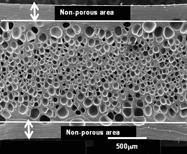Crossref Citations
This article has been cited by the following publications. This list is generated based on data provided by
Crossref.
Sun, Xiaofei
Kharbas, Hrishikesh
and
Turng, Lih‐Sheng
2015.
Fabrication of highly expanded thermoplastic polyurethane foams using microcellular injection molding and gas‐laden pellets.
Polymer Engineering & Science,
Vol. 55,
Issue. 11,
p.
2643.
Chu, Chien-Chia
Yeh, Shu-Kai
Peng, Sheng-Ping
Kang, Ting-Wei
Guo, Wen-Jeng
and
Yang, Jintao
2017.
Preparation of microporous thermoplastic polyurethane by low-temperature supercritical CO2 foaming.
Journal of Cellular Plastics,
Vol. 53,
Issue. 2,
p.
135.
Acikbas, Nurcan Calis
and
Acikbas, Gokhan
2017.
Epoxy Matrix Composites Containing Urea Formaldehyde Waste Particulate Filler.
Waste and Biomass Valorization,
Vol. 8,
Issue. 3,
p.
669.
Yeh, Shu-Kai
Liu, Yu-Che
Chu, Chien-Chia
Chang, Kung-Chin
and
Wang, Sea-Fue
2017.
Mechanical Properties of Microcellular and Nanocellular Thermoplastic Polyurethane Nanocomposite Foams Created Using Supercritical Carbon Dioxide.
Industrial & Engineering Chemistry Research,
Vol. 56,
Issue. 30,
p.
8499.
Shin, Cheolmin
Chung, Hyunjae
Kim, Eungchul
Hong, Seokjun
Kwak, Donggeon
Jin, Yinhua
Kulkarni, Atul
and
Kim, Taesung
2018.
Monitoring the Physicochemical Degradation of Polishing Pad Soaked in Hydrogen Peroxide during Chemical Mechanical Polishing.
ECS Journal of Solid State Science and Technology,
Vol. 7,
Issue. 2,
p.
P77.
Yeh, Shu-Kai
Chen, Ying-Ru
Kang, Ting-Wei
Tseng, Tzu-Jian
Peng, Sheng-Ping
Chu, Chien-Chia
Rwei, Syang-Peng
and
Guo, Wen-Jeng
2018.
Different approaches for creating nanocellular TPU foams by supercritical CO2 foaming.
Journal of Polymer Research,
Vol. 25,
Issue. 1,
Wang, Tianxian
and
Lei, Hong
2019.
Novel polyelectrolyte–Al2O3/SiO2 composite nanoabrasives for improved chemical mechanical polishing (CMP) of sapphire.
Journal of Materials Research,
Vol. 34,
Issue. 6,
p.
1073.
Wang, Shiping
Xue, Shuaiwei
Ge, Chengbiao
Ren, Qian
Zhao, Dan
and
Zhai, Wentao
2019.
Preparation of fluorescent thermoplastic polyurethane microcellular foam films blown by supercritical CO2.
Journal of Cellular Plastics,
Vol. 55,
Issue. 5,
p.
483.
Bouhfid, Nabil
Raji, Marya
Boujmal, Radouane
Essabir, Hamid
Bensalah, Mohammed-Ouadi
Bouhfid, Rachid
and
Qaiss, Abou el kacem
2019.
Modelling of Damage Processes in Biocomposites, Fibre-Reinforced Composites and Hybrid Composites.
p.
57.
Wortman-Otto, Katherine M.
Graverson, Carolyn F.
Linhart, Abigail N.
McDonough, Rose K.
Mlynarski, Amy L.
and
Keleher, Jason J.
2020.
Synergistic Effect of Pad “Macroporous-Reactors” on Passivation Mechanisms to Modulate Cu Chemical Mechanical Planarization (CMP) Performance.
ECS Journal of Solid State Science and Technology,
Vol. 9,
Issue. 5,
p.
054005.
Norhaniza, Rizuan
Mazlan, Saiful Amri
Ubaidillah
Abdul Aziz, Siti Aishah
Nazmi, Nurhazimah
and
Yunus, Nurul Azhani
2020.
Enhancement of sensitivity of magnetostrictive foam in low magnetic fields for sensor applications.
Polymer,
Vol. 211,
Issue. ,
p.
123083.
Fujita, Takashi
2020.
Evaluation of correlation between chemical modification state of pad and polishing rate in oxide chemical mechanical planarization.
Thin Solid Films,
Vol. 709,
Issue. ,
p.
138233.
Černý, Miroslav
Petruš, Josef
Kučera, František
Pavliňáková, Veronika
Kupka, Vojtěch
Poláček, Petr
and
Chamradová, Ivana
2020.
A new approach to the structure–properties relationship evaluation for porous polymer composites.
SN Applied Sciences,
Vol. 2,
Issue. 4,
Pan, Ruiqi
Yang, Lei
Zheng, Li
Hao, Liang
and
Li, Yan
2020.
Microscopic morphology, thermodynamic and mechanical properties of thermoplastic polyurethane fabricated by selective laser sintering.
Materials Research Express,
Vol. 7,
Issue. 5,
p.
055301.
Khanna, Aniruddh J.
Yamamura, Mayu
Kakireddy, Veera Raghava
Chockalingam, Ashwin
Jawali, Puneet
Baradanahalli Kenchappa, Nandan
Hariharan, Venkat
Redfield, Daniel
and
Bajaj, Rajeev
2020.
Investigation of the Impact of Pad Surface Texture from Different Pad Conditioners on the CMP Performance.
ECS Journal of Solid State Science and Technology,
Vol. 9,
Issue. 6,
p.
064011.
Shabani, Amin
Fathi, Amir
Erlwein, Sebastian
and
Altstädt, Volker
2021.
Thermoplastic polyurethane foams: From autoclave batch foaming to bead foam extrusion.
Journal of Cellular Plastics,
Vol. 57,
Issue. 4,
p.
391.
Yeh, Shu-Kai
Rangappa, Raghavendrakumar
Hsu, Ting-Hao
and
Utomo, Stephen
2021.
Effect of extrusion on the foaming behavior of thermoplastic polyurethane with different hard segments.
Journal of Polymer Research,
Vol. 28,
Issue. 7,
Terashkevich, D. I.
Bokova, E. S.
Ginzburg, A. S.
and
Kovalenko, G. M.
2021.
Microstructure analysis of polyurethane based polishing materials.
Plasticheskie massy,
p.
3.
Santiago-Calvo, Mercedes
Naji, Haneen
Bernardo, Victoria
Martín-de León, Judith
Saiani, Alberto
Villafañe, Fernando
and
Rodríguez-Pérez, Miguel Ángel
2021.
Analysis of the Foaming Window for Thermoplastic Polyurethane with Different Hard Segment Contents.
Polymers,
Vol. 13,
Issue. 18,
p.
3143.
Hsiao, Yu-Ting
Hsieh, Chieh-Ming
Yang, Tsung-Mao
and
Su, Chie-Shaan
2021.
Preparation of Microcellular Foams by Supercritical Carbon Dioxide: A Case Study of Thermoplastic Polyurethane 70A.
Processes,
Vol. 9,
Issue. 9,
p.
1650.





